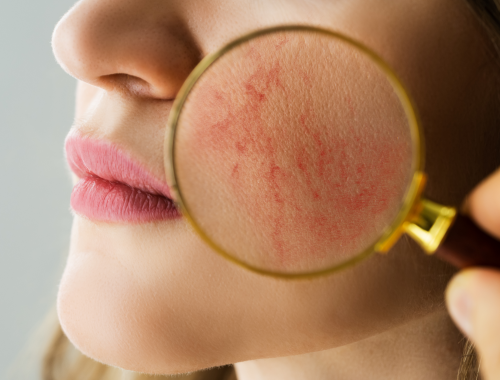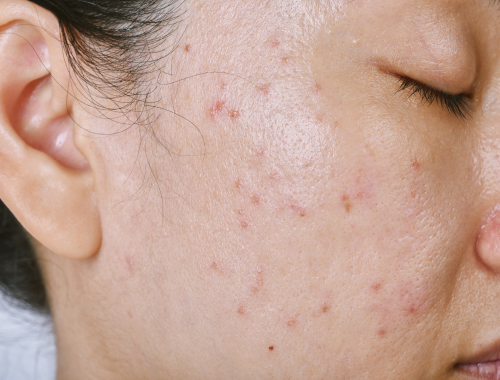Difference Between Acne Rosacea and Acne Vulgaris
People get confused between acne vulgaris (pimples) and acne rosacea (persistent facial redness) because of how similar they look. However, they are two very different kinds of skin conditions, and treating each of them requires a different strategy. The pore (tiny openings around hair follicles and sweat glands) enlarges and transforms into a whitehead in acne vulgaris. Due to the swelling that appears immediately underneath the surface, it is less noticeable in rosacea. Rosacea from acne doesn’t happen because of an infection.
Similarity
- Both conditions appear as red bumps on your skin
- Skin irritation etc.

Acne Rosacea
Rosacea is a chronic inflammatory skin issue (a response by our immune system that stays around long after injury or infection) that typically affects the nose and cheeks and results in flushed skin (reddening of the skin) and a rash. It might also result in eye issues. Other issues like exposure to high UV rays, emotional stress can flare up the symptoms and go away.

Acne Vulgaris
Acne vulgaris (pimples) is a common chronic skin disease that affects the pilosebaceous units (hair follicles, hair shaft and the sebaceous glands that surround them), which comprise of a piliary component and a sebaceous component. Acne typically affects the face, but it can also affect the back and chest. It can appear as non-inflammatory lesions (usually aren’t swollen or painful), inflammatory lesions (are painful and swollen), or a combination of both.
Difference between Acne Rosacea and Acne Vulgaris
Definition
Acne rosacea is a condition that frequently causes little lumps on the face that are red and filled with pus. The condition is most common in fair-skinned middle-aged (40-50) women.
Acne Vulgaris
Acne vulgaris (pimples) is a common chronic skin condition that affects or causes swelling of the pilosebaceous units (hair shaft, the hair follicle, the sebaceous gland that surround them).
Symptoms
Acne Rosacea
Redness on chin, cheeks, forehead, nose, swelling, burning sensation, blurred vision, thicker skin, swollen eyes, pimples, visible blood vessels.
Acne Vulgaris
Whiteheads, blackheads, itchiness, Erythema, closed comdones, tender skin, red bumps, pustules
Cause
Acne Rosacea
-Infectious bug in the intestines
– Inflammation is one of the major reasons
– Environmental stressors like UV light
– Skin redness and rash
– heightened skin sensitivity
Acne Vulgaris
- Propionibacterium acnes in adolescence
- Genetics
- Lack of sleep
- Unsafe cosmetics
- Clogging of hair follicles
Age
Acne Rosacea
Between 30 and 50 years of age
Acne Vulgaris
Usually starts in adolescence and common in teenagers and young adults.
Distribution
Acne Rosacea
Forehead, nose, cheeks, eyelids, brows, chin
Acne Vulgaris
Face, shoulders and torso
Risk factors
Acne Rosacea
- Women are more vulnerable to acne rosacea
- Adults in the age group of thirty and sixty are at higher risk of getting it
- History of acne rosacea
- Sun exposure
Acne Vulgaris
- Genetic predisposition
- Oil-based skin products
- Hormonal imbalance
- Infections
- Medications
- Polycystic Ovarian Syndrome
- Stress
Summary
The points of difference between Acne Rosacea and Acne Vulgaris have been summarized as below:

FAQ:
How can acne rosacea be differentiated from acne vulgaris?
| Acne vulgaris | Acne Rosacea | |
| Areas Affected | Widespread | Reddening of central face (flush areas) |
| Occurrence | Chronic or extreme | Episodically (changing at usually irregular intervals) |
| Triggers | Varied | UV rays, heat, alcohol, intense emotions, food items with lot of spices, caffeine |
What does acne from rosacea look like?
Areas of facial redness (blushing or flushing due to rosacea) might erupt into acne-like lumps and pimples that are red or pus-filled clear blood vessels. On the cheekbones and nose, these usually take the form of fine red lines. thinning of the skin.
What are three signs of acne vulgaris?
- Pimples (pustules with pus at their tips, nodules and bumps on face
- A great variety of lesions
- Whiteheads and blackheads which are closed (former) and open (later) plugged pores
What are the 4 stages of acne vulgaris?
Comedones (open (blackhead) or closed (whitehead) skin pore), papules (Small raised, soft bump on the skin), pustules (red bumps with shite pus) and cysts.
What does acne vulgaris look like?
Whiteheads or blackheads are how comedones (one of the stages of acne vulgaris) are visible. Blackheads (open comedones) look very similar to whiteheads in appearance but have a darker centre. Whiteheads are flesh-colored or whitish palpable lesions (fluid-filled or solid) that range in size from one to three mm. Pustules are red bumps or raised lesions with a white or yellowish pus.
What are the two types of acne rosacea?
Type 1 – vascular rosacea
Type 2 – inflammatory rosacea
- Difference Between Global Warming and Greenhouse Effect - May 18, 2024
- Difference Between Vaccination and Immunization - March 3, 2024
- Difference Between Selective Mutism and Autism - February 25, 2024
Search DifferenceBetween.net :
Leave a Response
References :
[0]Plewig, G., & Kligman, A. M. (2012). Acne and rosacea. Springer Science & Business Media.
[1]Picardo, M., Eichenfield, L. F., & Tan, J. (2017). Acne and rosacea. Dermatology and therapy, 7, 43-52.
[2]Tuchayi, S. M., Makrantonaki, E., Ganceviciene, R., Dessinioti, C., Feldman, S. R., & Zouboulis, C. C. (2015). Acne vulgaris. Nature reviews Disease primers, 1(1), 1-20.
[3]Zaenglein, A. L. (2018). Acne vulgaris. New England Journal of Medicine, 379(14), 1343-1352.
